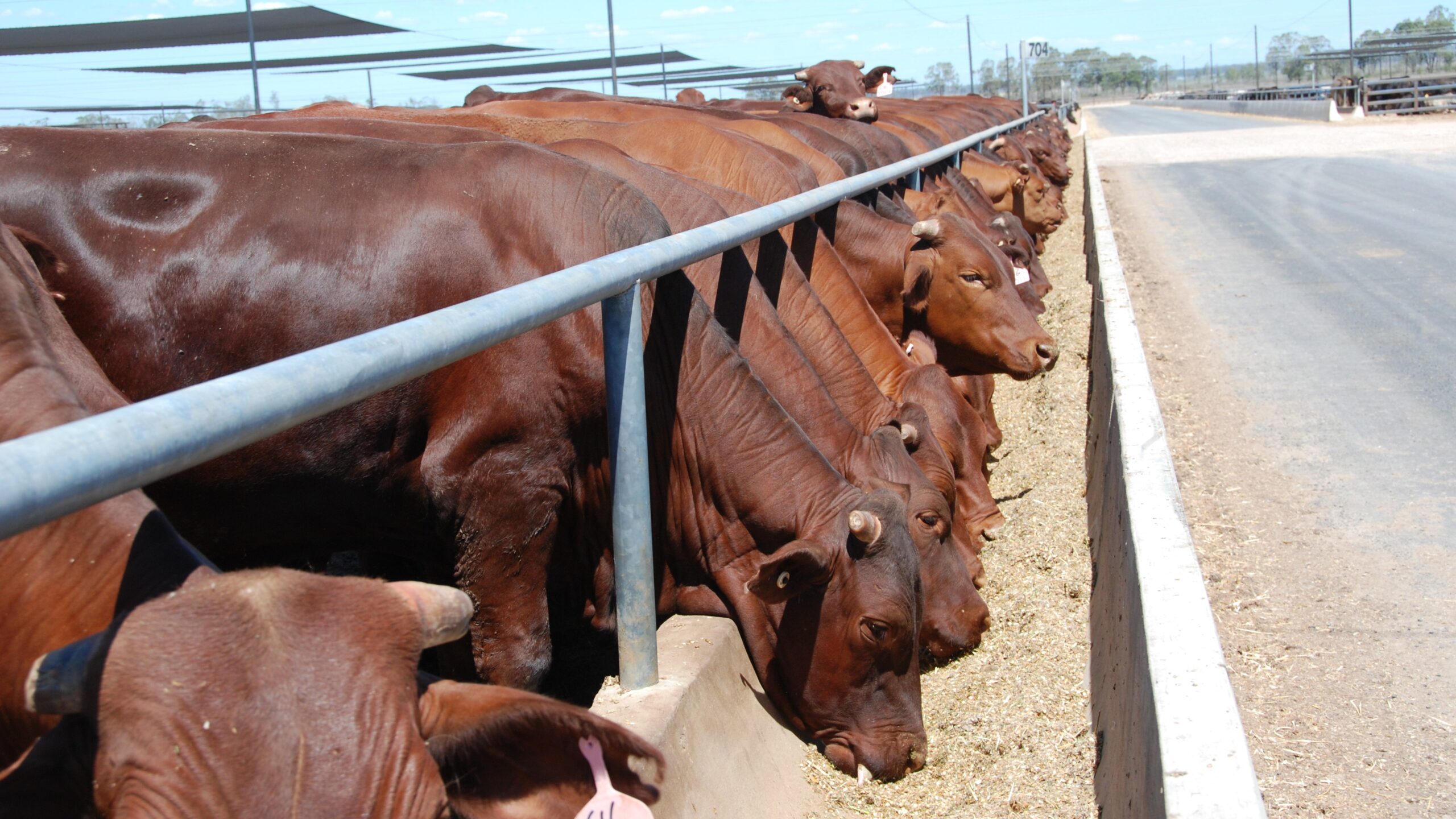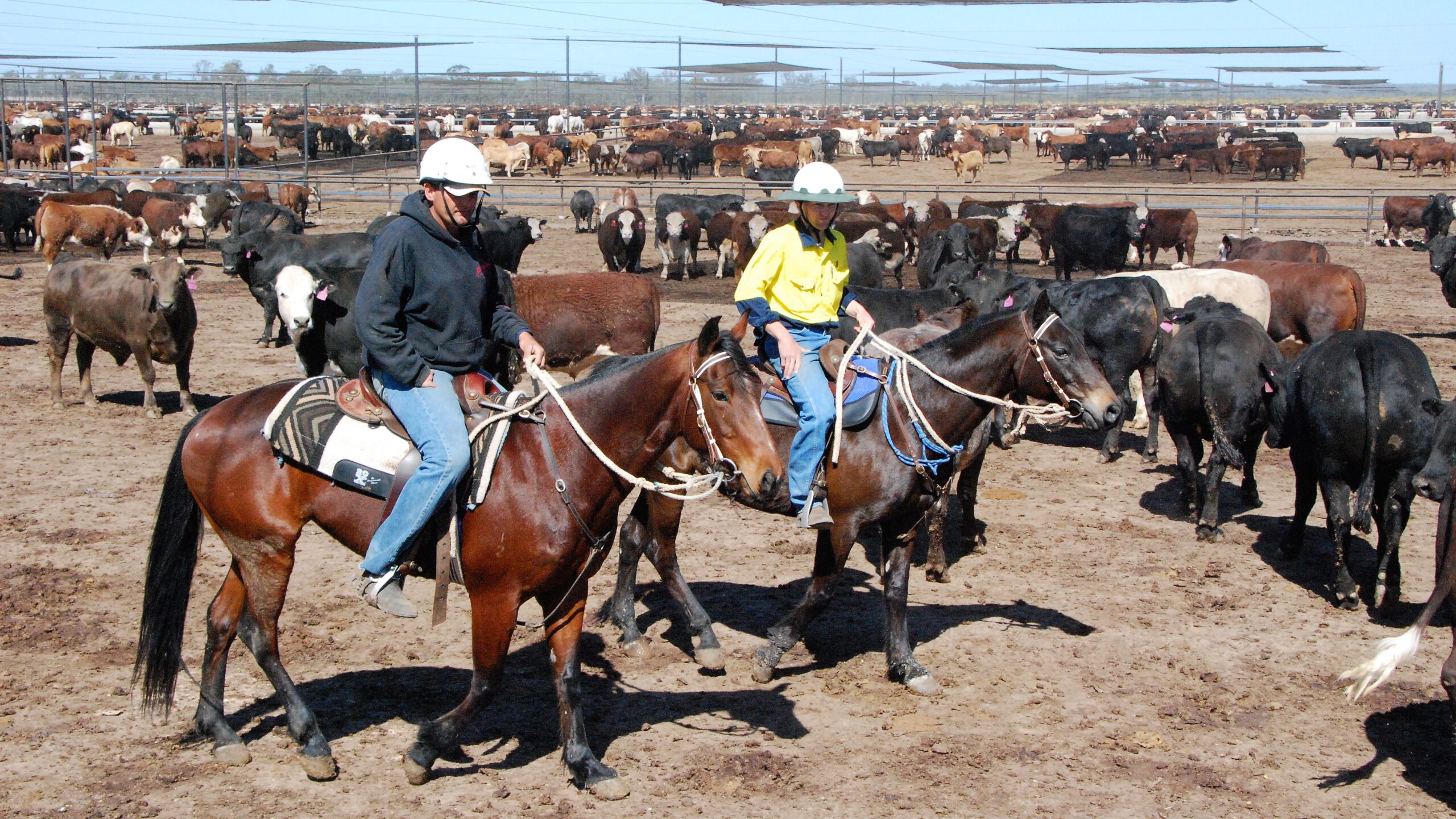Managing beef cattle feedlots

Four distinct factors impact feedlot profitability:
- buying price of store cattle
- selling price of finished cattle
- cost of the diet
- cattle performance, as influenced by management.
Each factor is important and requires consideration before commencing a feedlot venture as feedlot margins are often marginal. That is to say, a great deal of value is placed on checking the economics, securing contracts and selecting cattle which perform well, consistently meeting market specifications.
Feedlot management influences cattle performance through its impact on feed intake, weight gain and herd health.
The following is an outline of procedures considered by most well run feedlots.
On arrival/induction
Cattle arriving at the feedlot are usually tired and uncomfortable in their new surroundings. For that reason, it is important they are fed and watered as soon as possible with good quality hay and fresh drinking water.
Usually, within one week cattle are inducted into the feedlot. Induction includes identification, weighing, vaccination, drenching and tipping of horns if required. Some feedlots will use a hormone growth promotant depending upon company policy and market specifications.
At induction, cattle may receive preventative treatments, including:
- 5 in 1 vaccine to cover clostridial diseases such as enterotoxaemia, tetanus and malignant oedema. To be affective, the vaccine requires two treatments, four to six weeks apart.
- Vaccination to cover bovine respiratory disease (BRD)
- In Queensland, cattle arriving from southern states may require treatment for liver fluke
- Lice treatment is required during winter.
On going cattle management

The health and welfare of the cattle is part of routine feedlot management conducted daily.
Cattle are observed daily for:
- signs of disease onset
- feed problems (for example, shy feeders)
- failure to adapt to the diet
- ‘bad doers’ – it often pays to remove these animals.
Water troughs need to be large enough to provide ample fresh water at all times. This is because reduced water intake results in digestive compaction, resulting in reduce feed intake and therefore, weight gain. Troughs are usually cleaned at a minimum of twice a week.
Feed processing
Processing the grain in a ration is beneficial as cracked grain gives approximately 15% better utilisation than whole grain. Doing so, increases weight gains and reduces grain wastage. Grain can be coarsely milled, either through a roller mill or hammermill, however milling the grain too fine needs to be avoided. Finely milled grain increases the risk of digestive upsets.
Steam flaking of sorghum will further improve its digestibility.
Dusty diets can also depress appetite and cause respiratory problems. Including small quantities of molasses will overcome this issue and increase palatability. At most, molasses can be fed at up to 10% of the diet.
Introducing cattle to grain: open troughs (or bunks)
Cattle must have grain introduced into their diet gradually. A slow introduction over time allows the rumen microbes to adjust to a grain diet, thereby minimising the incidence of grain poisoning and laminitis.
The following feeding program is a satisfactory method of bringing cattle on to a high grain diet.
| % In diet | ||
|---|---|---|
| Grain and additives | Hay | |
| Day 1 to 4 | 20 | 80 |
| Day 5 to 8 | 40 | 60 |
| Day 9 to 12 | 60 | 40 |
| Day 13 to 15 | 80 | 20 |
| Day 16+ | Final ration | |
However gradually the new diet is introduced, cattle will need to be continually observed during this period for sickness and other health problems. Information regarding diet formulations can be found here.
Feeding
Bunk management
Feeding out at the same time each day reduces the incidence of metabolic upsets. Likewise, it is important that cattle have feed in the troughs at all times, as empty feed troughs are the prime cause of grain poisoning.
Feeding excessive quantities each day is not recommended as the feed becomes stale and unattractive. Where possible, try and judge the amount fed so that a little is left over each day. That is to say, cattle are never without access to feed.
The exception to this rule is in the event of wet weather. At these times, it may be necessary to feed two to three times a day to avoid feed spoilage/wastage.
If you have to change grains during the feeding period, it is important that it is done over a 14-day period. Particularly when converting from a sorghum based diet to a barley based diet, but not as critical for the reverse.
Introducing cattle to grain: self feeders
Grain intake can be restricted with self feeders by initially using a narrow opening (for example, 12 mm) and then gradually raising the shutters over two weeks. Initial mixes are usually 50:50 grain and hay by weight, to assist the mixture to ‘flow’.
The following method for self feeders has been used successfully in commercial feedlots.
| Introduction strategy | |
|---|---|
| Day 1 to 4 | Provide the starter diet in self feeders with a narrow shutter opening while feeding hay separately in racks. If necessary, place hay on top of the grain in the self feeder trough to attract cattle to the grain. |
| Day 5 to 7 | Gradually increase the daily intake of grain by opening the shutters. |
| Day 8 to 14 | Provide free access to the starter diet. If mixing your own diet, gradually increase the grain percentage of the diet over the next week. |
| Day 15+ | Free access to the final diet. It is optional as to whether hay feeding in racks continues. |
Stock density
Stocking rates are influenced by rainfall, animal size and class of feedlot, keeping in mind that both dusty and boggy conditions need to be avoided. The National Feedlot Accreditation Scheme generally requires between nine and 25 square metres per Standard Cattle Unit (SCU). A Standard Cattle Unit is defined as an animal of 600 kg liveweight, at the time of exit (turn-off) from the feedlot.
Feed space
Actual space needed varies with ration, cattle size and feeding frequency, however, 20 cm per head is the suggested minimum for local trade and Japanese export cattle.
The following may be used as a guide:
| Feed trough space (cm/head) | Self feeders (cm/head) | |
|---|---|---|
| Yearling | 25 to 30 | 10 to 20 |
| 18 months to 2 years | 30 to 38 | 20 to 25 |
| Bullocks | 38 to 46 | 25 to 30 |
The feed bunk spacings described above caters for one feeding per day. When feeding is carried out more frequently, the required spacing approaches the self-feeder recommendations.
National Feedlot Accreditation Scheme (NFAS)
Meat marketed with the AUS-MEAT ‘grain-fed’ description must come from feedlots accredited under the NFAS. This is an industry quality assurance scheme administered by AUS-MEAT. Details of this scheme and associated costs may be obtained from AUS-MEAT telephone 1800 621 903 or email ausmeat@ausmeat.com.au.
Written by Roger Sneath and Greg Bath, Department of Agriculture and Fisheries.